Ryan Hall's Blog, page 278
March 17, 2016
Shoe Of The Week: Hoka One One Clayton
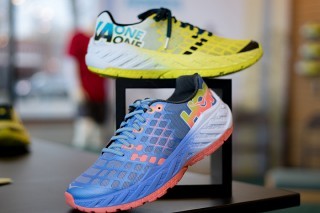
With the Clayton, Hoka created a light, fast, cushioned and very stable racing flat. Photo: Matt Trappe
Since inception six years ago, Hoka One One has made a huge splash—especially in the ultrarunning world—with its thickly cushioned maximalist shoes, blowing conventional shoe design out of the water and winning numerous awards along the way. But from the start, the company has said its mission has been to create shoes for all types of running—on the trail, road, track—through innovative, forward-thinking design concepts. While it has continued to refine its thickly cushioned shoes, it is also developed a series of speed shoes that are a bit lower to the ground and built for racing. One of the first to hit stores is the Clayton, a thickly cushioned shoe that has been engineered to offer cushioning, protection and energy return. The result is a category-breaking long-distance trainer/racer that’s both exceptionally wide and very stable but also impressively light, responsive and fast. (The Clayton launched exclusively at JackRabbit Sports stores across the U.S. on March 1, but it will become available at all running specialty shops and online in April.)
There are several key elements that make the Clayton special and unique. The first is a two-part midsole that features a slightly softer foam in the rear for impact protection at footstrike and a firmer, very responsive foam material in the forefoot that results in amazing energy return as the foot rolls forward to the toe-off phase of a stride. The Clayton also retains Hoka’s “rockered” design and its energetic RMAT foam material on the bottom of outsole that work together to help smooth the foot’s movement from heel to toe. The ride feels buttery smooth and well cushioned, but also firm, edgy and fast. Few shoes—and none with this much cushion—have combined all of those different elements so well. (Hoka launched the Huaka shoe as a energetic racing shoe two years ago, but this shoe is much firmer and snappier than the Huaka was.)
While the Clayton provides a snug fit from the heel to the midfoot and slightly wider in the toe box, the shoe’s exterior profile is extremely wide to provide optimal lateral stability. The foot sits low inside the shoe and the medial sidewall extends slightly higher—innovative ways to help reduce overpronation late in a long race or run without being as disruptive as a traditional medial post. (Hoka will also unveil a lighter and less protective racing flat called the Tracer in April.)
This is the shoe for you … if you’re looking for a lightweight, responsive and extremely stable shoe for long-distance training and racing.
Price: $150
Weights: 7.3 oz. (men’s size 9.0); 6.3 oz. (women’s size 7.0)
Heel-Toe Offsets: 4mm, 24mm (heel); 20mm (forefoot)
Info: Hokaoneone.com
RELATED: Shoe Of The Week—On Running Cloudflyer
The post Shoe Of The Week: Hoka One One Clayton appeared first on Competitor.com.
Ryan Hill Hoping for Hometown Edge at World Indoors
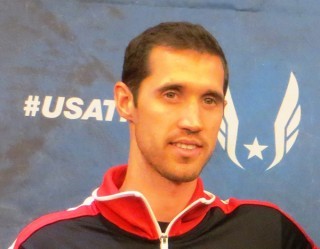
Photo: Chris Lotsbom
(c) 2016 Race Results Weekly, all rights reserved. Used with permission.
PORTLAND — Looking out of his bedroom window, Ryan Hill can see the twin glass spires that rise high above the Oregon Convention Center here, home to the IAAF World Indoor Championships. The spires, built in 1989, are meant to let light into the Convention Center. They also serve as a reminder that Hill’s preliminary 3000m race against the world is almost here.
“Right now it hasn’t even sunken in that it’s a World Championships because I’ve just been hanging out at my house, doing what I normally do,” said a supremely relaxed Hill, speaking to members of the media at a Team USA press event. Hill, who moved here after graduating from North Caroline State, lives two miles from the track. “Hopefully it will sink in once I get there and it feels like a World’s stage. Right now I’m really relaxed.”
On Friday, Hill will race the preliminary round of the 3000m, and is a favorite to make it—and potentially medal—in Sunday’s final. The 3000m, a distance that is often contested only indoors, is right in Hill’s wheelhouse.
At 26, Hill has quickly become one of America’s most steady distance aces on the oval, having won national titles at 3000m indoors (just last week in 7:38.60); two miles indoors (2015, 8:26.72); and 5000m outdoors (2015, 13:50.69). It is on the 200m indoor track that Hill feels most at ease, able to let loose on the banked surface.
“It probably helps that the 3000m is my best event. It’s something that I’ve never run outdoors, but is the main thing indoors for me. Just the distance in itself is probably the biggest advantage for me,” he said. “Me and my [Nike Bowerman Track Club] group have been training like 5000m runners, and just racing the 3000m off it. We’re still training like 5000m runners. I wouldn’t say we’ve changed specifically for the 3000m, but the event just suits me and my system pretty well.”
Training under the watchful eye of Jerry Schumacher, Hill’s development has been consistent. With the Olympic Games looming in the distance, Hill is considered one of the main contenders to don the USA singlet this summer over 5000m. Using the indoor season as a springboard for the months to come, Hill has gained momentum through his two races this winter: a 7:38.82 win at the NYRR Millrose Games—in a thrilling sprint finish over Hassan Mead—and the aforementioned victory at last week’s national championships.
“Our 5000m training is very hard 5000m training, and the 3000m is very similar. For me it just ends a lot quicker. I can start my kick sooner so it’s more of a comfort zone for me,” said Hill.
Asked to gauge his fitness, Hill wasn’t shy about making a bold statement.
“I think we’re in great shape. I think I’m in a lot better shape than Jerry even thinks I’m in. I think I’m a little past the seven or eight he wants,” Hill said, ranking his fitness on a scale of one to 10. Ten is representative of true peak form, reserved for the Olympic Trials and Olympic Games. Hill has trained through much of this indoor season. “I feel like I’m ready to run just as well as I could.”
Unlike his three previous international world championships (two in outdoor track and one in cross country), Hill has the benefit of the true hometown advantage here. Staying at home, Hill is keeping as low a profile as possible: he is training at his usual spots, staying at home rather than at the team hotel, and not altering his routine.
As not to get too complacent, Hill will go to the track tomorrow and do his pre-race routine, then will go out to dinner as if he was racing outside of the Rose City.
Trying to avoid too bold of a prediction, Hill said that a top five finish was doable, and a medal would only come on a very great day. Yet his tone changed slightly once interviews shifted to a one-on-one style, reiterating his confidence and high level of fitness.
Hill is prepared for any kind of pace at these championships, though would prefer to avoid any sit-and-kick shenanigans. He does have a training partner—Canada’s Mo Ahmed—entered in the 3000m. Yet the pair likely won’t employ any team tactics, as was on display at last week’s USA Championships.
“Let’s not rule anything out, we still have a team going,” he said sarcastically.
“I don’t want it to be too slow, because then just anything can happen. Luck of the draw kind of thing,” he said. “I’ll be looking for any opportunity to kind of string it out a little bit. But obviously I don’t want to do any work because you’re pretty much sacrificing yourself. I would like it to be a little out there, chip away some people. That’d be great.”
With the home crowd behind him, Hill hopes to put on a show to remember. After all, international championships are not held on U.S. soil often. The last time these championships were held in the United States was in 1987.
“I feel really at ease and relaxed and I think that’ll probably help me out in the end,” he said. “Hopefully it’ll be entertaining, it’ll be good for the American fans. I just hope it’s a good competition for the American track fans.”
The post Ryan Hill Hoping for Hometown Edge at World Indoors appeared first on Competitor.com.
Workout of the Week: The Hill-Tempo Sandwich
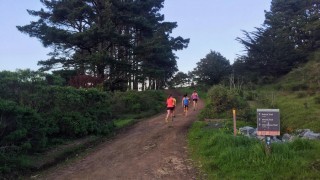
Hill repeats help improve speed, power and explosiveness. Photo: Mario Fraioli
More often than not, most of the challenging workouts runners do on a regular basis tend to emphasize one of four things: power, speed, stamina or specificity. For example, you might do some short hill sprints to develop lower leg strength, power and explosiveness, an interval session to improve your 5K race pace or a 30-minute tempo run to work on your endurance and/or dial in your race pace for an upcoming half marathon or marathon.
And while there’s nothing wrong with this individualized approach to assigning and executing workouts, there can be great benefit to mixing some of these different elements into the same session from time to time.
One of my favorite workouts sandwiches two sets of 20-second hill repeats around two shorter tempo runs. This alternating session challenges both the musculoskeletal and aerobic systems, ensuring that you’re recruiting fast-twitch muscle fibers and emphasizing speed, power and explosiveness to some degree at a time when your main focus is improving your aerobic endurance or getting comfortable being uncomfortable at your goal race pace. In short, you get more bang for your training buck!
Here’s how to do it:
— Warm up with 10-20 minutes of easy jogging, followed by dynamic stretching, drills and strides.
— On a hill with a 7-8 percent grade, run 3-6 20-second uphill repeats at around 90 percent effort. Focus on attacking the hill, running with erect posture, quick turnover, good knee lift and your arms driving you forward.
— Walk or jog slowly down the hill to your starting point after each repeat, taking 60-90 seconds for recovery. After the final hill rep, jog slowly for 2:00 to a flatter stretch of road or trail.
— Following your 2:00 jog recovery, run a 2-3 mile tempo run (or up to 25 minutes if you train by time) on the flatter stretch of road or trail at your goal half-marathon race pace/effort. Running out and back from the base of the hill will serve you well for this portion of the workout.
— If you’re new to speed workouts, your session is over and you are done. Cool down with 10-20 minutes of easy jogging and light stretching. For more experienced runners, there’s another set awaiting you! After finishing the tempo run, jog for 3-4 minutes as recovery, then head back to the hill for another set of hill reps and a second tempo run. After completing the second part of the workout, cool down with 10-20 minutes of easy jogging and light stretching.
Note to runners undertaking a second set: You will not be nearly as fresh as you were when you did the first set, so pay close attention to running with strong form on the hills and not letting your mechanics fall apart. The tempo run, in particular, will be significantly more challenging the second time around. Focus on staying relaxed and fast while maintaining consistent turnover from beginning to end.
RELATED:
— Workout Of The Week: Steep Hill Sprints
— Workout Of The Week: Mile Repeats
The post Workout of the Week: The Hill-Tempo Sandwich appeared first on Competitor.com.
Out There: We’re Not Young Anymore

You’re not 20 anymore (and it kind of sucks).
Getting older sucks sometimes. Your back aches, all of your mail goes from amusing things you ordered on Amazon to not-so-amusing things from your mortgage company, and eventually you concede that convenience store burritos (though delicious) are probably not such a great breakfast after all.
If we could go back to being 20, I think most of us would probably do it for a couple of weeks. Let’s face it—our early 20s come with a complimentary pair of rose-colored glasses. Our bodies are resilient enough and our brains are stupid enough. It’s a fun combination, really.
And then things change. Even though it’s happened 100 billion times to other people, growing up is still a big surprise when it happens to you. It’s a deceptive transformation —one day, you’re streaking through campus and the next you’re yelling at those damn college kids to put on some clothes.
And that’s when it hits you: you’re one of them. You’re <shudder> a grown-up.
Suddenly, your grown-up-ness pervades everything. You become aware of it in all aspects of your life, from the responsible car you drive (a Subaru, really?) to the fact that you take a daily multivitamin. As a grown-up runner, the realizations continue to pile on: no longer do you grab a piece of cold pizza from the fridge on the way out the door to your local half marathon—no, you have a race-morning routine. You fuel. You partake in nutrition. It’s so sensible, it gives 20-year-old you a permanent case of the eye rolls. Other realizations you have as a grown-up runner:
You become a snob about your running shoes. The discount pile at the sporting goods store may have been a godsend to your college budget, but today just looking at it makes your knees give out. The only time cheap shoes are allowed now is if you’re mowing the lawn. You don’t contribute bi-weekly to a savings account to subject your feet to subpar cushioning.
You see strangers at a party wearing stilettos and must resist the urge to warn them about how they are ruining their feet. Plantar fasciitis is no joke.
Young runners look really young. Don’t marathons have an 18-and-up rule? Have his growth plates even closed yet? Do her parents know she’s here? When did they start letting babies run marathons?
Your hangovers are trying to kill you. Once upon a time, you could drink an entire bottle of Jagermeister on an empty stomach, go to bed at 3 a.m., and still turn in a 5K PR. Now? You’re still feeling that second glass of wine from happy hour. That was three days ago
You realize your metabolism is not what it used to be. I’ll just have the salad, thanks.
You’ve discussed this with your friends. Probably over salad.
No alarm clock is needed to wake up in time for your 6 a.m. run. Who are you, and why are you so damn chipper?
You start writing strongly worded letters. Races that give away cotton t-shirts instead of tech tees, neighbors who don’t shovel their sidewalks, equestrians with the audacity to allow their horses to poop on your favorite running trail—everyone gets an extremely sassy piece of your mind.
You stop obsessing over ridiculous standards for your body. I’ve finally accepted that the only six-pack I will ever have is the one currently sitting in my fridge.
You start obsessing over other parts of your body instead. When did my hands become so wrinkly?
Race fees have their own budget category. Because you actually have a budget now, like a grown-ass individual who learned the hard way how credit card interest works.
You become a germaphobe. You used to make fun of those “mom types” for carrying Purell everywhere, until one day you finally saw the pre-race port-o-john for the seething den of E. coli that it is. Now you carry a Costco-sized jug in a holster on your race belt.
You skip the post-race beer tent. The idea of drinking cheap beer out of plastic cups in a tent crowded with half marathon finishers sounds like an actual circle of hell. I can barely handle my own body odor, much less that of 300 strangers. Also, did anyone card those kids over there? There is no way they’re 21.
Sometimes, you just need to sit down. I’m tired, y’all.
It was just yesterday that you were a young, fresh-faced runner. Where did the time go?
You ask yourself “Where did the time go?” a lot.
* * *
About The Author:
Susan Lacke does 5Ks, Ironman Triathlons and everything in between to justify her love for cupcakes (yes, she eats that many). Susan lives and trains in Salt Lake City, Utah with three animals: A labrador, a cattle dog, and a freakishly tall triathlete husband. She claims to be of sound mind, though this has yet to be substantiated by a medical expert. Follow her on Twitter: @SusanLacke.
The post Out There: We’re Not Young Anymore appeared first on Competitor.com.
March 16, 2016
Trail of the Week: Zion Traverse, Zion National Park

Photo: Elyse Ordorica
Our Trail of the Week feature is made possible through a partnership with Trail Run Project, a crowd-sourced collaboration by and for the running community. Thanks to Tom Robson for mapping and describing this route.
Truly a bucket-list run for the serious adventure runner, this traverse of beautiful Zion National Park in Utah approaches 50 miles in length and runs the gamut with regards to elevation change, temperatures, water scarcity and desert terrain.
Runners go both east-to-west and west-to-east in this adventure, starting at either the Lee Pass Trailhead or the East Rim Trailhead.
Along the way, runners will see just what’s so special about Zion—the breathtaking cliffs, high plateaus, winding rivers and more.
A single-day run is doable if you’re an advanced runner, but many do the traverse as a multi-day backpacking adventure. If you do the latter, you need a permit.
RELATED: 8 Epic Running Adventures in America’s National Parks
The Data
Miles: 48.7
Runnable: 91 percent
Average Grade: 70 percent
Max Grade: 47 percent
Total Ascent: 6,467 feet
Total Descent: -6,780 feet
Highest Elevation: 7,445 feet
For a closer look, check out the interactive map, data, photos and virtual run simulator courtesy of Trail Run Project:
The post Trail of the Week: Zion Traverse, Zion National Park appeared first on Competitor.com.
Race Ambassadors a Big Way for Events to Attract Runners
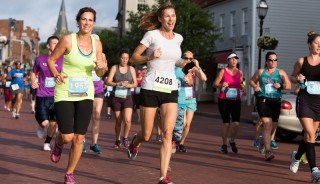
The ZOOMA Annapolis Half Marathon and 10K.
With tens of thousands of running events in the United States each year, organizers face a growing dilemma: How do you stand out and bring runners to your race?
The answer often lies among participants themselves. Thanks to social media, runners have become highly visible fans for the runs they love.
Race directors have taken notice and turned that enthusiasm into the best kind of advertising: word of mouth. Race ambassador or race advocate programs, which rely on volunteer runners, have become a popular—and relatively inexpensive—way for organizers to publicize their events.
In return for their efforts, runners receive prizes such as free race entries, running gear and gift cards. Many programs give their ambassadors special codes to distribute to the runners they recruit. When those runners register for the race, the ambassadors get credits toward specific prizes.
“It’s a good way for the people who are already strong advocates for our race to be rewarded,” says Alexa Strobridge, regional brand manager for Life Time Athletic Events, which organizes the Novo Nordisk New Jersey Marathon & Half Marathon.
The Pioneer Programs
The ZOOMA Women’s Race Series was one of the first running events to have an ambassador program, says ZOOMA founder Brae Blackley. When she started the program six years ago, her goal was to increase registrations.
Since then, it has grown from just a marketing strategy into a close-knit community of women.
As a result, Blackley has relaxed the program’s requirements over the years. The biggest change is that ambassadors no longer have to refer a certain number of runners in order to get a free race entry. If they are selected to be an ambassador, they can compete in one or all three of the races free of charge.
“We’re in a friendship as opposed to a business relationship,” she says. “It’s more like a club.”
Blackley used to have a point system with lots of prizes, but it became too much to manage and took on a negative tone. Some ambassadors who brought in a lot of registrations viewed the program as a job and complained they weren’t getting enough in return, she says.
“You want people to be promoting participation because they believe in it and the mission, not because they feel like they have a job to do,” she says.
Blackley looks for women who are good race promoters and have a positive attitude.
“Most of our ambassadors have blogs or are very active on social media,” she says. “They are already very passionate and inspiring other people to run. It’s a natural fit.”
ZOOMA ambassador Erika Howder, 45, of Arlington, Va., says before becoming an ambassador for any race, make sure you are doing it for more than just a free entry.
“If you don’t think a race is good enough to pay for, you shouldn’t be an ambassador,” she says. It’s also important to look at the requirements and make sure you have the time to do them, she adds.
ZOOMA is not the only race series with an evolving ambassador program. The Hot Chocolate 15K/5K Race Series began one in 2012, but organizers have made a lot of adjustments to it since then, says Josiah Ragsdale, experiential marketing supervisor with RAM Racing.
At first, organizers focused on high-profile runners to promote the races, but it became apparent the events needed supporters who had strong local running connections. Because the events are only once a year in each city, it’s important to have ambassadors who can ramp up excitement ahead of time.
“I don’t want people who are just social media-centric,” he says. “You have to be literally engaged in the community. I look for people that other people already know. They are active in running clubs. They produce local races.”
This year, the race series, which is held in 14 cities nationwide, has 90 ambassadors.
Ragsdale explains that volunteers have to dedicate about five hours a week over 10 months for activities such as race expos.
“I try and email everyone once a week,” he says. “I would say it is important to develop a strong sense of community, so you don’t feel like you are a supervisor and an employee.”
But the program is serious business, too.
“I bring back ambassadors year after year, if they enjoy it, and they have a lot of redemptions,” he says .
Such dedication seems to pay off. For example, one top performer recently earned a flight to a Hot Chocolate race with a friend, a hotel stay and other prizes.
RELATED: Race-Cation Trip Planning a Booming Business
A New Idea for Some Races
This is the first year the New Jersey Marathon & Half has an ambassador program, Strobridge says, and the 12 selected ambassadors must meet certain requirements to get rewards. For example, they have to organize two promotional events for the race, such as leading a group run or handing out flyers at their local gym.
Ambassadors are also expected to spread the word through social media. In order to get a free entry to the marathon, ambassadors must get five runners to register for the race. The more runners they refer, the bigger the prizes. Ambassadors who get 50 people to register receive a $300 gift card to the running store of their choice.
The hope is that the ambassadors will help draw more runners from outside New Jersey. The event typically has about 8,000 participants, and there is room to grow, Strobridge says.
Ambassador Elaine Acosta, 41, of Somerset, N.J., says because she is a member of the Raritan Valley Road Runners, involved with her local gym and active on social media, taking part in the program isn’t a huge commitment.
The rewards are fun, but she also enjoys helping other runners as an ambassador.
“If it’s your first marathon or half or first event, it’s good to have someone you can get in touch with for questions,” she says. “It can be intimidating.”
A Chance to Share a Message
Not all ambassadors are drawn to the program for the prizes. Corey Queen, 43, of Louisville, Ky., is an ambassador for the Kentucky Derby Festival Marathon and miniMarathon.
He says he enjoys his role because it gives him a platform to share his story. In 2010, Queen was 100 pounds heavier and suffering from severe sleep apnea. Queen was in such poor health, he feared he could die in his sleep. So he started running, and in 2011, finished the Kentucky Derby Marathon, his first marathon.
But he wasn’t managing his work stress well, and in 2014, he suffered a stress-induced heart attack at a work function.
His brush with death convinced him to quit his job. These days, Queen takes care of his four children most of the time and works a few days as a personal trainer.
“It’s a world of difference,” he says. “When I’m going to work I’m happy, and when I’m coming home I’m happy, instead of carrying the weight of the world on my shoulders.”
He frequently gets messages on social media from strangers who read his story on the Derby Marathon website and list him as their race ambassador. As a result, he has brought in some 50 race registrations. “I don’t really get caught up in it,” he says.
Queen, who will be running the Derby Marathon for the third time on April 30, hopes to especially inspire people who have just started running.
“I remember the first race I ever did was a 5K,” he says. “The first time I crossed that finish line and my kids were cheering me and my wife was cheering me. My wife tearing up. I have never forgotten that. I feel like everyone deserves that feeling.”
The post Race Ambassadors a Big Way for Events to Attract Runners appeared first on Competitor.com.
Runners: An Easier Way to Become a Better Fat Burner

In the fall of 2015, ultrarunner and blogger Matthew Laye placed himself on a high-fat, low-carbohydrate (HFLC) diet. He got 70 percent of his daily calories from fat and limited his carbohydrate intake to 50 grams per day or less. Laye had read that, by doing this, he would teach his muscles to burn more fat and less carbohydrate when he ran, and his endurance would increase. He embarked upon his HFLC diet journey with high hopes.
Those hopes didn’t last long. Many runners feel lousy for a while as they adapt to a HFLC diet. But Laye never stopped feeling lousy. “I was running nearly a minute [per] mile slower than my normal easy pace,” he reported on his blog. “Fast and hilly running, when I occasionally attempted them, were [nearly] impossible.” Worse, when Laye had blood work done, he discovered that his LDL (“bad”) cholesterol level had skyrocketed. He quit the diet.
Laye’s experience is very common. Many if not most runners who experiment with HFLC diets feel lousy, get slower, and suffer health consequences. Others report positive results, but even for them there are costs, including an unpleasant and disruptive transition period and tremendously restricted food and meal options.
Fortunately, recent science is showing that it’s possible to gain the benefits of HFLC without the consequences through alternative methods that are much less extreme. Specifically, the practice of performing select workouts in a carbohydrate-deprived state has been proven to provide an extra fitness boost—even for athletes who are already fit.
The latest scientific support for this practice comes from a study conducted by researchers at the French National Institute of Sport (FBIS) and published in the respected journal Medicine & Science in Sports & Exercise. The subjects were 21 well-trained triathletes, who were separated into two groups. Both groups were placed on relatively high-carb diets that supplied six grams of carbohydrate per kilogram of bodyweight daily. But on four days of each week, the members of one group got all of their carbs from their first two meals of the day and ate no carbs at dinner. These carb-free dinners followed an intense interval workout that members of the other group also performed.
The morning after the interval workout, all of the subjects completed an easy one-hour workout before breakfast. This workout was done in a mildly carbohydrate-deprived state by the triathletes who had followed the previous day’s interval session with a normal dinner but was done in a severely carbohydrate-deprived state by those who had followed the same workout with a zero-carb dinner.
These dietary and training patterns were kept up for three weeks. All of the subjects completed performance tests before and after this 21-day period. Members of the group that practiced carb-fasted training saw significant improvements in cycling efficiency, high-intensity cycling performance, and running performance within a triathlon time trial. There were no such improvements among members of the other group.
It’s important to note that high-fat diets and other low-carb diets have never been linked to performance gains in tests like these. In fact, they have repeatedly been linked to performance decrements including loss of anaerobic power, decreased VO2 Max, and reduced time-trial performance. That’s at least partly because the improvement in fat-burning capacity that comes from eating HFLC is counteracted by loss of carbohydrate-burning capacity, which is at least as important. But the subjects of the FNIS study (or half of them, at least) got the best of both worlds: a general diet that was high in carbohydrate to support maximum performance in hard workouts combined with the opportunity to gain the advantages of doing some easier workouts in a carbohydrate-deprived state.
The results of this study should not be taken to indicate that all athletes must follow precisely the same protocol to obtain the benefits of carb-fasted training. In fact, the protocol was a little weird, featuring high-intensity interval workouts on four consecutive days for three straight weeks—something that no successful endurance athlete I’m aware of does in the real world. I suspect that you can benefit just as much from employing the sequence of high-intensity afternoon workout/no-carb dinner/sleep/easy pre-breakfast workout just once or twice a week over a longer time period.
Also, as a nutritionist, I don’t like to see athletes or anyone else eat no-carb meals very often. The only natural foods that contain zero carbohydrate are meat, fish, and eggs. An all-meat/fish/egg dinner is not exactly nutritionally balanced.
An alternative to the protocol used in the FNIS study that does not require zero-carb meals is the early-morning endurance workout. Used more often by elite athletes, this approach entails doing a long, low-intensity workout either before breakfast or after a light, no-carb breakfast (e.g., a hardboiled egg and black coffee) and during which only water is consumed. You might want to consider alternating this type of workout with the FNIS protocol, employing one of the two formats this week, the other next week, and so on.
There’s no need to get too scientific in incorporating carb-fasted training into your race preparations. Just make it a regular, minor element of your routine in a way that fits your lifestyle. Indeed, it’s worth noting that Kenya’s elite runners practice carb-fasted training for reasons that have everything to do with lifestyle and nothing to do with science. The typical elite Kenyan runner does the first of his or her two to three daily runs before breakfast every day, a habit that may be an underappreciated factor in Kenya’s dominance of the sport. It’s also worth noting that elite Kenyan runners eat more carbohydrate overall than do runners of any other nation except their only true rivals, the Ethiopians: 10 grams per kilogram of bodyweight per day, or 76 percent of total calories. Like I said: The best of both worlds.
The post Runners: An Easier Way to Become a Better Fat Burner appeared first on Competitor.com.
March 15, 2016
Yuki Kawauchi Runs 66-Minute Half Marathon In A Suit
Is there any race Japanese running hero Yuki Kawauchi won’t run? The working man’s marathoner, donning a full suit, ran 1 hour, 6 minutes and 42 seconds at the Kuki Half Marathon on Sunday, according to Brett Larner’s blog, Japan Running News.
Kawauchi’s mark at Kuki is much faster than that of American Gihan Amarasiriwardena’s 1:24:41 Guinness World Record for a half marathon in a suit, but Kuki isn’t a certified course, Kawauchi told Lerner after the race, so it won’t count in the record books.
A prolific racer, Kawauchi, who is 29 years old, works full-time for the government while training and racing at a high level. He’s run 2:08:14 for the marathon and has represented Japan in international competition on multiple occasions. Prior to his suited stunt at Kuki, he ran 2:11:53 for 7th place at the Lake Biwa Marathon.
川内優輝選手、スーツで快走
2016 Running Gear Guide: Trail Accessories

$135, Ultimatedirection.com
Part of the Jenny Collection, this vest is designed by women, for women, to ergonomically carry the essentials for a day trip into the wilderness. You choose whether you carry water flasks in the front pockets or drop a hydration sleeve in the pack, with additional pockets for extra layers, food, your phone and more.
The post 2016 Running Gear Guide: Trail Accessories appeared first on Competitor.com.
The Real Story of the First Woman to Run the Boston Marathon
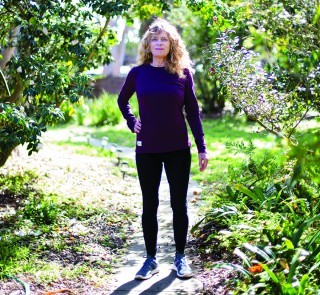
Photo: Scott Draper
In February of 1966, 23-year-old Roberta “Bobbi” Gibb opened her mailbox and eagerly tore open the letter from the Boston Athletic Association, expecting to see her race number. Instead, she found that her request for an application to that year’s Boston Marathon had been denied. She couldn’t believe the words she read.
“This is an AAU Men’s Division race only,” wrote race director Will Cloney. “Women aren’t allowed, and furthermore are not physiologically able.”
Gibb was outraged. Fifty years ago, opportunities for females in the work world and society in general were limited—but in running? Not physiologically able? “I could run 30 miles at a stretch!” she says.
A lifelong runner, Gibb ran in the woods as a kid in the Boston suburbs, played field hockey in high school and ran 7 or 8 miles a day with her cross-country runner boyfriend at Tufts University for no reason other than running made her feel “as free as a bird—such a sense of peace and wholeness and health.” She had been training for Boston for two years, ever since she’d watched the 1964 race. Standing enthralled at Wellesley College (Mile 13) as the runners passed by, she made a secret promise to herself: I will train. I will raise my mileage. I will do this!
So after running nearly every day for 700 days, getting married, moving to San Diego and even logging two 30-milers, she was ready for Boston—only to find out that women were banned.
“At that point, I could have said, ‘Well, too bad—I guess I won’t run.’” she says. “But instead, I said, ‘All the more reason to run it!’”
And when she did, she changed the world.
“People don’t realize what it was like back then,” says Gibb, 73, who today works as a neuroscience researcher at the University of California San Diego and makes sculptures in San Diego and Boston. “It was hard for a woman to become a doctor or lawyer, run a business, live on her own. A woman couldn’t get a mortgage or even have a credit card in her own name. It was really claustrophobic. As a teenager, I’d see all these unhappy suburban housewives taking tranquilizers and drinking to alleviate the pain of not being themselves. And now, on top of it, we aren’t even allowed to run?”
Gibb hadn’t planned to run the Boston Marathon to make a statement. But now, fired up by her rejection letter, that changed.
“I saw that this moment was bigger than me,” she says. “Once I did it, they’d not only change the rules, but change attitudes. It would throw into question other misbeliefs about what women were capable of.”
In April, Gibb curled up in a Greyhound bus seat for four days, heading 3,000 miles east from San Diego. She arrived the day before the race in Winchester, her childhood home in suburban Boston, and broke the news to her parents.
“My dad was angry,” she says.” Even though he was an MIT professor who had always encouraged me to reach for my dreams, he thought I was nuts, that I’d get hurt. But my mom understood. She had been frustrated her whole life—a gifted, intelligent woman who wasn’t able to do anything but be a housewife. She agreed that this would be important.” With a kiss for luck, mother dropped daughter off in the starting-line town of Hopkinton the morning of April 19, 1966.
The post The Real Story of the First Woman to Run the Boston Marathon appeared first on Competitor.com.
Ryan Hall's Blog
- Ryan Hall's profile
- 21 followers




